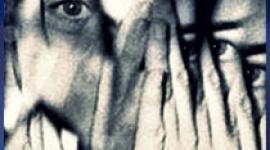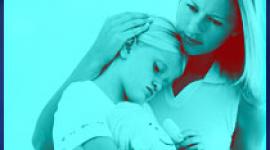Bipolar Disorder and Alcohol Abuse
 Relationship between bipolar disorder and alcohol misuse and abuse, exploring treatment and diagnostic issues.
Relationship between bipolar disorder and alcohol misuse and abuse, exploring treatment and diagnostic issues.
Inside the Bipolar Disorder and Alcohol Abuse Factsheet
- Introduction
- The relationship between bipolar disorder & alcohol misuse
- Where is bipolar disorder treated?
- Research findings: clinical characteristics
- Diagnostic issues
- Treatments for comorbid bipolar disorder & alcohol misuse
The Mental Health & Alcohol Misuse Project (MHAMP) provides factsheets, a newsletter and web pages aimed at sharing good practice between clinicians and professionals working in the mental health and alcohol fields. MHAMP promotes the inclusion of alcohol in strategies developed for the Mental Health National Service Framework, and updates the mental health and alcohol fields.
Project Factsheet 5:
This factsheet outlines the relationship between bipolar disorder and alcohol misuse, exploring treatment and diagnostic issues. Although bipolar disorder only affects 1-2% of the population, it often requires long-term treatment, which may involve a number of health and social care providers. Importantly, alcohol misuse is high among people with bipolar disorder, and it adversely affects the course of the illness.
Target audience
This factsheet is intended primarily for clinicians and staff working in mental health services, alcohol agencies and primary care. The factsheet may also be of interest to people working in Local Implementation Teams and Primary Care Trusts with an interest in commissioning and planning services to meet the needs of people with comorbid alcohol misuse and bipolar disorder.
Summary: The factsheet at a glance
- People with bipolar disorder are five times more likely to develop alcohol misuse or dependence than the rest of the population
- Comorbid bipolar disorder and alcohol misuse is commonly associated with poor medication compliance, heightened severity of bipolar symptoms, and poor treatment outcomes
- The complex relationship between co-existing alcohol problems and bipolar disorder demonstrates the pressing need to screen for and treat alcohol misuse in this group
- Alcohol misuse can mask diagnostic accuracy in determining the presence of bipolar disorder. Measures that can help determine whether bipolar disorder is present include taking a chronological history of when symptoms developed, considering family history, and observation of mood over extended periods of abstinence
- There are a number of treatment measures that may help those with concurrent alcohol misuse and bipolar disorder. These include screening for alcohol misuse in mental health and primary care settings, screening for mental health problems in primary care and substance misuse agencies and referral to mental health and substance misuse services as required, care planning, patient and carer advice and education, monitoring medication compliance, psychological interventions, and specialist relapse prevention groups.
Introduction
Description
Often called manic depression, bipolar disorder is a type of mood (affective) disorder that affects about 1-2% of the population (Sonne & Brady 2002). People with bipolar disorder experience extreme fluctuations in mood and levels of activity, from euphoria to severe depression, as well as periods of euthymia (normal mood) (Sonne & Brady 2002). Periods of elevated mood and increased energy and activity are called "mania" or "hypomania", while lowered mood and decreased energy and activity is considered "depression" (World Health Organization [WHO] 1992). Bipolar disorder may also include psychotic symptoms, such as hallucinations or delusions (O'Connell 1998).
Classification
Bipolar disorder can be characterised by different manifestations of the illness at different times. The ICD-10 features a range of diagnostic guidelines for various episodes of bipolar disorder: for example, current episode manic with or without psychotic symptoms; current episode severe depression with or without psychotic symptoms (WHO 1992). Bipolar disorders are classified as bipolar I and bipolar II. Bipolar I is the most severe, characterised by manic episodes that last for at least a week and depressive episodes lasting at least two weeks. People can also have symptoms of both depression and mania at the same time (called 'mixed mania'), which may carry a heightened risk of suicide. Bipolar II disorder is characterised by episodes of hypomania, a less severe form of mania, which lasts for at least four consecutive days. Hypomania is interspersed with depressive episodes that last for at least 14 days. Due to elevated mood and inflated self-esteem, people with bipolar II disorder often enjoy being hypomanic and are more likely to seek treatment during a depressive episode than a manic period (Sonne & Brady 2002). Other affective disorders include cyclothymia, characterised by persistent instability of mood, with frequent periods of mild depression and mild elation (WHO 1992).
As with many other mental illnesses, a significant proportion of people with bipolar disorder misuse alcohol, often complicating their condition. The American Epidemiologic Catchment Area study reported the following findings in relation to bipolar disorders and alcohol:
- 60.7% lifetime prevalence for substance misuse or dependence in persons with bipolar I disorder. Alcohol was the most commonly misused substance, with 46.2% of people with bipolar I disorder experiencing alcohol misuse or dependence at some point in their lives
- The lifetime prevalence of alcohol problems among people with bipolar II disorder was also very high. The likelihood of having bipolar II disorder and any substance misuse or dependence was 48.1%. Again, alcohol was the most commonly misused substance, with 39.2% having either alcohol misuse or dependence at some time in their lives
- For people with any bipolar disorder, the likelihood of having alcohol misuse or dependence is 5.1 times that of the rest of the population-Of the different mental health problems examined in the survey, bipolar I and bipolar II disorders ranked second and third respectively (after antisocial personality disorder) for lifetime prevalence of any alcohol diagnosis (misuse or dependence) (Regier et al. 1990).
The relationship between bipolar disorder and alcohol misuse
The relationship between alcohol misuse and bipolar disorder is complex and frequently bidirectional (Sonne & Brady 2002). Explanations for the relationship between the two conditions include the following:
- Bipolar disorder may be a risk factor for alcohol misuse (Sonne & Brady 2002)
- Alternatively, the symptoms of bipolar disorder may emerge during chronic alcohol intoxication or during withdrawal (Sonne & Brady 2002)
- People with bipolar disorder may use alcohol during manic episodes in an attempt at "self-medication", either to extend their pleasurable state or to dampen the agitation of mania (Sonne & Brady 2002)
- There is evidence of familial transmission of both alcohol misuse and bipolar disorder, suggesting a family history of bipolar disorder or alcohol misuse can be important risk factors for these conditions (see studies by Merikangas & Gelernter 1990; Preisig et al. 2001, cited in Sonne & Brady 2002)
Alcohol use and withdrawal may affect the same brain chemicals (ie neurotransmitters) involved in bipolar disorder, thereby allowing one disorder to alter the clinical course of the other. In other words, alcohol use or withdrawal may "prompt" the symptoms of bipolar disorder (Tohen et al. 1998, cited in Sonne & Brady 2002).
Where is bipolar disorder treated?
People with bipolar disorder are frequently treated by GPs and community mental health teams, and in a range of settings, including hospitals, psychiatric wards and psychiatric day hospitals, and special residential care (Gupta & Guest 2002).
Clinicians working with people with comorbid alcohol misuse and bipolar disorder should be competent in the treatment of addictions and bipolar illness. The integrated treatment advocated in the Dual Diagnosis Good Practice Guide entails the concurrent provision of psychiatric and substance misuse interventions, with the same staff member or clinical team working in one setting to provide treatment in a co-ordinated manner (Department of Health [DoH] 2002; see also Mind the Gap, published by the Scottish Executive, 2003). Integrated treatment helps to ensure that both comorbid conditions are treated.
Some dual diagnosis specialist substance misuse services - which include staffing by mental health professionals - also treat clients with comorbid bipolar disorder and alcohol problems (see, for example, MIDAS in East Hertfordshire, reported in Bayney et al. 2002).
Research findings: clinical characteristics
The following section looks at some of the clinical characteristics that the research literature has identified in people with comorbid bipolar disorder and alcohol misuse.
High incidence of comorbidity
As noted previously, of all the different mental health problems considered in the Epidemiologic Catchment Area study, bipolar I and bipolar II disorders ranked second and third for lifetime prevalence of alcohol misuse or dependence (Regier et al. 1990). Other researchers have also found high rates of comorbidity. For example, a study by Winokur et al. (1998) found that alcohol misuse is more frequent among people with bipolar disorder than those with unipolar depression. Therefore, despite the comparatively low incidence of bipolar disorder, the likelihood of alcohol misuse increases markedly with this condition.
Gender
As with the general population, men with bipolar disorder tend to be more likely than women with bipolar disorder to experience alcohol problems. A study by Frye et al. (2003) found that fewer women with bipolar disorder had a lifetime history of alcohol misuse (29.1% of subjects), compared with men with bipolar disorder (49.1%). However, women with bipolar disorder had a much greater likelihood of alcohol misuse compared with the general female population (odds ratio 7.25), than did men with bipolar disorder compared with the general male population (odds ratio 2.77). This suggests that, while men with bipolar disorder are more likely to present with comorbid alcohol misuse than women, bipolar disorder may particularly heighten women's risk of alcohol misuse (when compared to women without the disorder). The study also demonstrates the importance of mental health professionals carefully assessing alcohol use on an ongoing basis among both men and women with bipolar disorder (Frye et al. 2003).
Family history
There may be a link between family history of bipolar illness and alcohol misuse. Research by Winokur et al. (1998) found that, among people with bipolar disorder, familial diathesis (susceptibility) for mania is significantly associated with substance misuse. Family history may be more significant for men than for women. The study by Frye and colleagues (2003) found a stronger relationship between family history of bipolar disorder and alcohol misuse among men with this comorbidity than among women (Frye et al. 2003).
Other mental health problems
In addition to substance misuse problems, bipolar disorders often co-exist with other mental health problems. A study of patients with bipolar disorder found that 65% had lifetime psychiatric comorbidity for at least one comorbid problem: 42% had comorbid anxiety disorders, 42% substance use disorders, and 5% had eating disorders (McElroy et al. 2001).
Greater severity of symptoms/poorer outcome
Comorbidity of bipolar disorder and substance misuse may be associated with a more adverse onset and course of bipolar disorder. Comorbid conditions are associated with early age at onset of affective symptoms and the bipolar disorder syndrome (McElroy et al. 2001). Compared to bipolar disorder alone, concurrent bipolar disorder and alcohol misuse may lead to more frequent hospitalisations and has been associated with more mixed mania and rapid cycling (four or more mood episodes within 12 months); symptoms considered to increase treatment-resistance (Sonne & Brady 2002). If left untreated, alcohol dependence and withdrawal are likely to worsen mood symptoms, creating an ongoing cycle of alcohol use and mood instability (Sonne & Brady 2002).
Poor medication compliance
There is evidence to suggest that people with comorbid alcohol misuse and bipolar disorder are less likely to be compliant with medication than people with bipolar disorder alone. A study by Keck et al. (1998) followed up bipolar disorder patients discharged from hospital, finding that patients with substance use disorders (including alcohol misuse) were less likely to be fully compliant with pharmacological treatment than patients without substance misuse problems. Importantly, the study also showed that patients with full treatment compliance were more likely to achieve syndromic recovery than those who were noncompliant or only partially compliant. Syndromic recovery was defined as "eight contiguous weeks during which the patient no longer met criteria for a manic, mixed or depressive syndrome" (Keck et al. 1998: 648). Given the relationship of full treatment compliance to syndromic recovery, this study demonstrates the deleterious impact of substance misuse on bipolar disorder, reiterating the pressing need for the treatment of substance misuse.
Suicide risk
Alcohol misuse may increase the risk of suicide among people with bipolar disorder. One study found that 38.4% of their subjects with comorbid bipolar disorder and alcohol misuse make a suicide attempt at some point in their lives, compared to 21.7% of those with bipolar disorder alone (Potash et al. 2000). The authors suggest one possible explanation for the increase in suicide is the "transient disinhibition" caused by alcohol. Potash et al. also found that bipolar disorder, alcohol misuse and attempted suicide cluster in some families, suggesting the possibility of a genetic explanation for these concurrent problems. A non-genetic explanation may be intoxication's "permissive effect" on suicidal behaviour in people with bipolar disorder (Potash et al. 2000).
Determining a correct diagnosis is one of the principal concerns associated with comorbid alcohol misuse and (possible) bipolar disorder. Almost every person with alcohol problems reports mood swings, yet it is important to distinguish these alcohol-induced symptoms from actual bipolar disorder (Sonne & Brady 2002). On the other hand, early recognition of bipolar disorder may help commence appropriate treatment for the condition and lead to decreased vulnerability to alcohol problems (Frye et al. 2003).
Diagnosing bipolar disorder can be difficult because alcohol use and withdrawal, especially with chronic use, can mimic psychiatric disorders (Sonne & Brady 2002). Diagnostic accuracy may also be hampered due to underreporting of symptoms (particularly symptoms of mania), and because of common features shared by both bipolar disorder and alcohol misuse (such as involvement in pleasurable activities with high potential for painful consequences). People with bipolar disorder are also quite likely to misuse drugs other than alcohol (for example, stimulant drugs such as cocaine), which can further confuse the diagnostic process (Shivani et al. 2002). Therefore, it is important to consider whether a person misusing alcohol has an actual bipolar disorder or is merely showing symptoms similar to bipolar disorder.
Making a distinction between primary and secondary disorders can help determine prognosis and treatment: for example, some clients presenting with alcohol problems may have pre-existing bipolar disorder, and could benefit from pharmacological interventions (Schuckit 1979). According to one researcher, primary affective disorder "indicates a persistent change in affect or mood, occurring to the point of interfering with an individual's body and mind functioning" (Schuckit 1979:10). As noted, in people with bipolar disorder, both depression and mania will be observed in the client (Schuckit 1979). Primary alcohol misuse or dependence "implies that the first major life problem related to alcohol occurred in an individual who had no existing psychiatric disorder" (Schuckit 1979: 10). Such problems typically include four areas - legal, occupational, medical and social relationships (Shivani et al. 2002). In considering the relationship between primary and secondary disorders, one approach is to gather information from patients and their families and consider the chronology of when symptoms developed (Schuckit 1979). Medical records are also useful in determining the chronology of symptoms (Shivani et al. 2002).
Alcohol intoxication can produce a syndrome indistinguishable from mania or hypomania, characterised by euphoria, increased energy, decreased appetite, grandiosity, and sometimes paranoia. However, these alcohol-induced manic symptoms generally occur only during active alcohol intoxication - a period of sobriety would make these symptoms easier to differentiate from mania associated with actual bipolar I disorder (Sonne & Brady 2002). Similarly, alcohol-dependent patients undergoing withdrawal may appear to have depression, but studies have shown that depressive symptoms are common in withdrawal, and may persist for two to four weeks following withdrawal (Brown & Schuckit 1988). Observation over lengthier periods of abstinence following withdrawal will help determine a diagnosis of depression (Sonne & Brady 2002).
Given their more subtle psychiatric symptoms, bipolar II disorder and cyclothymia are even more difficult to diagnose reliably than bipolar I disorder. The researchers Sonne and Brady suggest that it is generally appropriate to diagnose bipolar disorder if bipolar symptoms clearly occur before the onset of alcohol problems or if they persist during periods of sustained abstinence. Family history and the severity of symptoms may also be useful factors in making a diagnosis (Sonne & Brady 2002).
In summary, means to help determine a possible diagnosis of comorbid bipolar disorder include:
- Taking a careful history of the chronology of when symptoms developed
- Considering family and medical history, and severity of symptoms
- Observation of mood over extended periods of abstinence if possible.
Treatments for comorbid bipolar disorder and alcohol misuse
Pharmacological treatments (such as the mood stabilizer lithium) and psychological treatments (such as cognitive therapy and counselling) may work effectively for patients with bipolar disorder alone (O'Connell 1998; Manic Depression Fellowship). Electroconvulsive therapy (ECT) has been effective in treating mania and depression in patients who, for example, are pregnant or unresponsive to standard treatments (Hilty et al. 1999; Fink 2001).
As noted earlier, concurrent alcohol misuse complicates the prognosis and treatment of people with bipolar disorder. However, there is little published information on specific pharmacological and psychotherapeutic treatments for this comorbidity (Sonne & Brady 2002). The following section is not intended as clinical guidance, but as an exploration of treatment considerations for this group.
Screening for alcohol misuse in mental health and primary care settings
Given the significance of alcohol in intensifying the symptoms of psychiatric disorders, clinicians in primary care and mental health services should screen for alcohol misuse when patients present with symptoms of bipolar disorder (Schuckit et al. 1998; Sonne & Brady 2002). A useful tool to gauge alcohol consumption is the World Health Organization's Alcohol Use Disorders Identification Test (AUDIT). Download AUDIT at: http://whqlibdoc.who.int/hq/2001/WHO_MSD_MSB_01.6a.pdf
Referral to mental health services for assessment
Early recognition of bipolar disorder may help commence appropriate treatment for the illness and lead to decreased vulnerability to alcohol problems (Frye et al. 2003). In conjunction with local mental health services, and with suitable training, substance misuse agencies should develop screening tools for mental health problems. This action may help determine whether clients need referral to mental health services for further assessment and treatment.
Treating the addiction and providing education
Given the negative impact of alcohol problems and the benefits of reducing consumption, it is important to treat alcohol problems in people with bipolar disorder. For example, reducing or stopping alcohol intake is recommended in the treatment of rapid cycling in bipolar patients (Kusumakar et al. 1997). In addition, education about the problems associated with alcohol misuse can help clients with pre-existing psychiatric problems (including bipolar disorder) (Schuckit et al. 1997).
Care planning
The Care Programme Approach (CPA) provides a framework for effective mental health care, and comprises:
- Arrangements for assessing the needs of people accepted into mental health services
- The formulation of a care plan that identifies the care required from different providers
- The appointment of a key worker for the service user
- Regular reviews of the care plan (DoH 1999a).
The Mental Health National Service Framework emphasises that the CPA should be applied to people with dual diagnosis, whether they are located in mental health or substance misuse services, beginning with a proper assessment (DoH 2002). A specialist dual diagnosis service in Ayrshire and Arran in Scotland illustrates the use of care planning for people with comorbid mental health and substance misuse problems. At Ayrshire and Arran, care programmes are planned in full consultation with the client, along with a thorough assessment of attendant risk. Care is rarely provided by the dual diagnosis team alone, but in liaison with mainstream services and other organisations relevant to the client's care (Scottish Executive 2003).
Given the complex problems associated with comorbid bipolar disorder and alcohol misuse - such as high suicide risk and poor mediation compliance - it is important that clients with this comorbidity have their care planned and monitored through the CPA. Carers of people on CPA also have the right to an assessment of their needs and to their own written care plan, which should be implemented in consultation with the carer (DoH 1999b).
Medication
Medications frequently used for treating bipolar disorder include the mood stabiliser lithium and a number of anticonvulsants (Geddes & Goodwin 2001). However, these drugs might not be as effective for people with comorbid problems. For example, several studies have reported that substance misuse is a predictor of poor response of bipolar disorder to lithium (Sonne & Brady 2002). As noted, medication compliance can be low among people with bipolar disorder and substance misuse, and the efficacy of medications is frequently being tested (Keck et al. 1998; Kupka et al. 2001; Weiss et al. 1998). For reviews of medications, see Weiss et al. 1998; Geddes & Goodwin 2001; Sonne & Brady 2002.
Psychological interventions
Psychological interventions such as cognitive therapy may be effective in the treatment of bipolar disorder, possibly as an adjunct to medication (Scott 2001). These interventions can also be useful in treating people with co-existing alcohol problems (Sonne & Brady 2002; Petrakis et al. 2002). Cognitive therapy in patients with bipolar disorder aims "to facilitate acceptance of the disorder and the need for treatment; to help the individual recognise and manage psychosocial stressors and interpersonal problems; to improve medication adherence; to teach strategies to cope with depression and hypomania; to teach early recognition of relapse symptoms and coping techniques; to improve self-management through homework assignments; and to identify and modify negative automatic thoughts, and underlying maladaptive assumptions and beliefs" (Scott 2001: s166). Over a number of sessions, patient and therapist identify and explore problem areas in the patient's life, concluding with a review of the skills and techniques learned (Scott 2001). Cognitive therapy is not the only therapy that can be used for bipolar disorder patients - psychotherapies of proven efficiency in major depressive disorder, such as family therapies, are also being piloted (Scott 2001).
Relapse prevention group
The American researchers Weiss et al. (1999) have developed a manualised relapse prevention group therapy specifically for the treatment of comorbid bipolar disorder and substance misuse. As an integrated programme, the therapy focuses on the treatment of both disorders simultaneously. The group is not considered suitable for patients with acute symptoms of bipolar disorder. Participants must also be seeing a psychiatrist who is prescribing their medication. Weiss et al. are currently evaluating the effectiveness of this therapy.
The major goals of the program are to:
- "Educate patients about the nature and treatment of their two illnesses
- Help patients gain further acceptance of their illnesses
- Help patients offer and receive mutual social support in their effort to recover from their illnesses
- Help patients desire and attain a goal of abstinence from substances of abuse
- elp patients comply with the medication regimen and other treatment recommended for their bipolar disorder" (Weiss et al. 1999: 50).
Group therapy comprises 20 hour-long weekly sessions, each covering a specific topic. The group begins with a "check-in", in which participants report their progress towards meeting the treatment goals: saying whether they used alcohol or drugs in the preceding week; the state of their mood during the week; whether they took medications as directed; whether they experienced high risk situations; whether they used any positive coping skills learned in the group; and whether they anticipate any high risk situations in the coming week.
After check-in, the group leader reviews the highlights of the previous week's session and introduces the current group topic. This is followed by an instructive session and a discussion of the current topic. At each meeting, patients receive a session handout summarising the main points. Resources are also available at each session, including information about self-help groups for substance misuse, bipolar disorder and dual diagnosis issues.
Specific session topics cover areas such as:
- The relationship between substance misuse and bipolar disorder
- Instruction on the nature of "triggers"- ie, high-risk situations that might trigger substance misuse, mania and depression
- Reviews on the concepts of depressive thinking and manic thinking
- Experiences with family members and friends
- Recognising early warning signs of relapse to mania, depression and substance misuse
- Alcohol and drug refusal skills
- Using self-help groups for addiction and bipolar disorder
- Taking medication
- Self-care, covering skills for establishing a healthy sleep pattern and HIV risk behaviours
- Developing healthy and supportive relationships (Weiss et al.1999).
next: Substance Abuse and Mental Illness
~ bipolar disorder library
~ all bipolar disorder articles
References
Bayney, R., St John-Smith, P., and Conhye, A. (2002) 'MIDAS: a new service for the mentally ill with comorbid drug and alcohol misuse', Psychiatric Bulletin 26: 251-254.
Brown, S.A. and Schuckit, M.A. (1988) 'Changes in depression among abstinent alcoholics', Journal of Studies on Alcohol 49 (5): 412-417.
Department of Health (1999a) Effective Care Coordination in Mental Health Services: Modernising the Care Programme Approach, A Policy Booklet (http://www.publications.doh.gov.uk/pub/docs/doh/polbook.pdf)
Department of Health (1999b) A National Service Framework for Mental Health (http://www.dh.gov.uk/en/index.htm)
Department of Health (2002) Mental Health Policy Implementation Guide: Dual diagnosis Good Practice Guide .
Fink, M. (2001) 'Treating bipolar affective disorder', letter, British Medical Journal 322 (7282): 365a.
Frye, M.A. (2003) 'Gender differences in prevalence, risk, and clinical correlates of alcoholism comorbidity in bipolar disorder', American Journal of Psychiatry 158 (3): 420-426.
Geddes, J. and Goodwin, G. (2001) 'Bipolar disorder: clinical uncertainty, evidence-based medicine and large-scale randomised trials', British Journal of Psychiatry 178 (suppl. 41): s191-s194.
Gupta, R.D. and Guest, J.F. (2002) 'Annual cost of bipolar disorder to UK society', British Journal of Psychiatry 180: 227-233.
Hilty, D.M., Brady, K.T., and Hales, R.E. (1999) 'A review of bipolar disorder among adults', Psychiatric services 50 (2): 201-213.
Keck, P.E. et al. (1998) '12-month outcome of patients with bipolar disorder following hospitalization for a manic or mixed episode', American Journal of Psychiatry 155 (5): 646-652.
Kupka, R.W. (2001) 'The Stanley Foundation Bipolar Network: 2. Preliminary summary of demographics, course of illness and response to novel treatments', British Journal of Psychiatry 178 (suppl. 41): s177-s183.
Kusumakar, V. et al (1997) 'Treatment of mania, mixed state, and rapid cycling', Canadian Journal of Psychiatry 42 (suppl. 2): 79S-86S.
Manic Depression Fellowship Treatments (http://www.mdf.org.uk/?o=56892)
McElroy, S.L. et al. (2001) 'Axis I psychiatric comorbidity and its relationship to historical illness variables in 288 patients with bipolar disorder', American Journal of Psychiatry 158 (3): 420-426.
O'Connell, D.F. (1998) Dual disorders: Essentials for Assessment and Treatment, New York, The Haworth Press.
Petrakis, I.L. et al. (2002) 'Comorbidity of alcoholism and psychiatric disorders: An overview', Alcohol Research & Health26 (2): 81-89.
Potash, J.B. (2000) 'Attempted suicide and alcoholism in bipolar disorder: clinical and familial relationships', American Journal of Psychiatry 157: 2048-2050.
Regier, D.A. et al. (1990) 'Comorbidity of mental disorders with alcohol and other drug abuse: results from the Epidemiologic Catchment Area (ECA) study', Journal of the American Medical Association 264: 2511-2518.
Schuckit, M.A. (1979) 'Alcoholism and affective disorder: diagnostic confusion', in Goodwin, D.W. and Erickson, C.K. (eds), Alcoholism and Affective Disorders: Clinical, Genetic, and Biochemical Studies, New York, SP Medical & Scientific Books: 9-19.
Schuckit, M.A. et al. (1997) 'The life-time rates of three major mood disorders and four major anxiety disorders in alcoholics and controls', Addiction 92 (10): 1289-1304.
Scott, J. (2001) 'Cognitive therapy as an adjunct to medication in bipolar disorder', British Journal of Psychiatry 178 (suppl. 41): s164-s168.
Scottish Executive (2003) Mind the Gap: Meeting the Needs of People with Co-Occurring Substance and Mental Health Problems (http://www.scotland.gov.uk/library5/health/mtgd.pdf )
Shivani, R., Goldsmith, R.J. and Anthenelli, R.M. (2002) 'Alcoholism and psychiatric disorders: diagnostic challenges', Alcohol Research & Health 26 (2): 90-98.
Sonne, S.C. and Brady, K.T. (2002) 'Bipolar disorder and alcoholism', Alcohol Research and Health 26 (2): 103-108.
Trevisan, L.A. et al. (1998) 'Complications of alcohol withdrawal: pathophysiological insights', Alcohol Health & Research World 22 (1): 61-66.
Weiss, R.D. et al. (1998) 'Medication compliance among patients with bipolar disorder and substance use disorder', Journal of Clinical Psychiatry 59 (4): 172-174.Weiss, R.D. et al. (1999) 'A relapse prevention group for patients with bipolar and substance use disorders', Journal of Substance Abuse Treatment 16 (1): 47-54.
World Health Organization (1992) The ICD-10 Classification of Mental and Behavioural Disorders: Clinical Descriptions and Diagnostic Guidelines, Geneva, World Health Organization.
next: Substance Abuse and Mental Illness
~ bipolar disorder library
~ all bipolar disorder articles
APA Reference
Staff, H.
(2008, February 6). Bipolar Disorder and Alcohol Abuse, HealthyPlace. Retrieved
on 2026, January 8 from https://www.healthyplace.com/bipolar-disorder/articles/bipolar-disorder-and-alcohol-abuse-compliance



